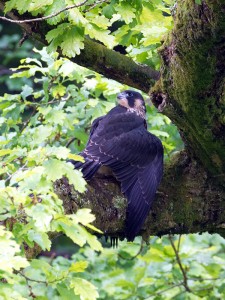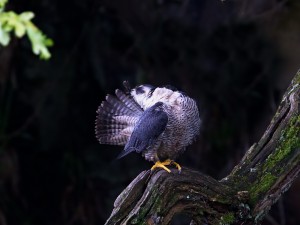What have the local starlings been feeding on?!?!
The transformation of our juvenile falcons in the last week has been remarkable. A week ago both were flightless, still a bit downy and had never left the safety of the eyrie. Both are now accomplished fliers, after only 4 days on the wing. This is quite unusual as you would expect during these early days for them to be clumsy, crash landing and staying low down. They have however been flying large circuits, landing where they aim for and sitting high up in spruce trees!

Both young birds have been chasing round the adults while calling for food. Despite their inexperience in the air they manage to keep up with him for a while. It is very impressive that they have enough control to land near him when he is sat on flimsy branches high up. They have also been landing near the tiercel, shouting and making themselves look big and threatening, when he is having a rest (I wonder who they learnt this behaviour from….)!
In some previous years young birds have stayed quite low at this stage. Their inability to direct flights and control their landing led them to land on paths and even the peregrine hut! So how come this years falcons are so competent in the air already? The experience of the adult pair and the fact they have been able to concentrate on just 2 chicks may have contributed.

I think the main factor however, may have been the provisioning to the young birds on the nest, particularly in the latter stages. This has been a very good year for starlings in the area, the tiercel bringing back up to 8 a day! This led the young birds to be very strong and keen to learn. At the moment they are far more interested in sitting up high, looking out for the adults and their next meal, than exploring the lower regions of the woodland
Both juveniles have stayed close to each other, even though they are not in the confines of the nest. (and despite being basically stuck together for the first few weeks of their lives!) this is usual, young peregrines are social. It is thought to be so they can look out for each other, keeping a watch out for predators and sounding the alarm. It is also useful for them to ‘play’ together in the air, to increase their manoeuvrability and build their flight muscles.
The young birds do still have much to learn. This morning the male gave one youngster (they get fed in turns now) a starling. It decided to eat it on the smallest of branches, bouncing around while trying to tear the prey apart and keep hold of it. It took the juvenile over 20 minutes to finish off the bird (it also dropped a bit). The adult falcon took a starling from the tiercel later in the day and finished it off in under 4 minutes! They are not yet plucking their food either. We can still tell the difference between our young birds, one having the light forehead. This is great as we can watch for individual behaviour differences and keep track of how much each is fed (very equally, as the mother often intervenes!).
The adult female is still feeding the chicks herself sometimes. She is a controlling but experienced mother. I suspect she is wanting to make sure that both get fed the right amount (not too much so they won’t practice their flying!) and that not too much food is wasted. Hopefully this won’t impact on their ability to feed themselves. I think it is unlikely as both are keen learners and watch the adults behaviour very closely. The falcon has been flying around a lot (even sometimes without food) calling to encourage the juveniles to chase her and fly around.
What I have learnt from this job, is just how much behaviour differs between peregrine pairs. It helps to show how complicated and intelligant these birds are. There is still much behaviour that can’t be explained, us orntithologists have much work to do!
What I have seen at other peregrine nesting areas (not until at least a week after fledging) is the adults passing the juveniles food in the air, to improve their co-ordination (very useful when hunting) and catching skills! The area around the gorge maybe a bit closed in for this activity but it will occur in the open areas when the youngsters venture that far. Going by the current rate of development this won’t be in the too distant future….. There is still much to see at the Falls of Clyde Peregrine site.
Tom Wells – Peregrine Protection Officer
Help protect Scotland’s wildlife
Our work to save Scotland’s wildlife is made possible thanks to the generosity of our members and supporters.
Join today from just £3 a month to help protect the species you love.
Preface
The transformation of our juvenile falcons in the last week has been remarkable. A week ago both were flightless, still a bit downy and had never left the safety of …
